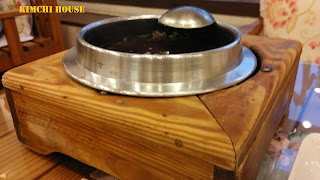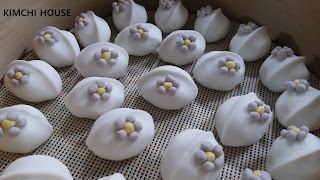These are the pumpkin puree and salad ~~
"Han Jeong Sik", a full -course Korean meal with a varied array of banchan (side dishes).
Korean cuisine is largely based upon rice, vegetables, and meats. Traditional Korean meals are noted for the number of side dishes (banchan) that accompany steam-cooked short-grain rice.Kimchi is served often, sometimes at every meal. Commonly used ingredients include sesame oil,doenjang (fermented bean paste), soy sauce, salt, garlic, ginger, pepper flakes and gochujang(fermented red chili paste).
Ingredients and dishes vary by province. Many regional dishes have become national, and dishes that were once regional have proliferated in different variations across the country.
(source: wikipedia)
"Han Jeong Sik"/韩定食,是韩国传统套餐,含有各种不同种类的小菜(banchan).
韩国料理中多以米食為主食,另有麵食、蕎麥、菜、肉等,除了炊煮熟食的飯之外,另外常伴隨熱湯同食。而冬天,醃製的韓國泡菜是飯桌上常見的配菜,以白菜、萝卜、黃瓜等各食材發酵而成,種類齊全而成為飯饌(반찬)。
烹調方面,由於受氣候影響,必須依季節而有調整。冬天寒冷農作物不興,蔬菜難以生長時必須仰賴泡菜、水泡菜、醬瓜等傳統醃製菜,這些醃製菜通常在入冬前被佐以鹽巴、辣椒等塗抹再放在大甕中存放,現代後有些醃製品改用玻璃罐擺在屋內。(source: wikipedia)
Jelly fish salad/海蜇沙拉
Glutinous rice pancake /糯米煎饼
Radish kimchi/萝卜泡菜
Green bean jelly and pork
Pork Belly and radish kimchi /三层肉和萝卜泡菜
Chives pancake, zucchini pancake & stonecrop kimchi/韭菜煎饼, 节瓜煎饼和景天属泡菜
Spicy octopus & noodle/辣酱八爪鱼&面
Stone pot rice/石锅饭
Sweet burdock /甜牛旁
Sesame leaves & cucumber kimchi /紫苏采泡菜和黄瓜泡菜
Spicy anchovies/辣酱江鱼子
Wild aster, radish & bracken sprout/马蹄菜,白萝卜&蕨菜
Zucchini/节瓜
"Deonjang Jjijae"/豆酱汤
The entrance of the restaurant/餐馆入口处( The address is 성남시 분당구 백현동 500-7 , Tel : (031) 701-6775 )
At the entrance of the restaurant/餐馆入口处
At the entrance of the restaurant/餐馆入口处
At the entrance of the restaurant/餐馆入口处
At the entrance of the restaurant/餐馆入口处
This is the main car park, there is another car park for this restaurant/这是餐馆的其中一个停车场,还有另外一个
Table setting/餐桌摆设
One of the corners in the restaurant/餐馆内一角落
Wine bar
One of the corners in the restaurant/餐馆内一角落
After having dinner, there is a cafe for the customer to have a cup of tea, coffee (free of charge)^-^/ 享用餐后,客人可移动到咖啡厅去享用茶或咖啡
We took "Sujeonggwa"/persimmon punch at the cafe
One of the corners in the cafe/餐馆内一角落
One of the corners in the cafe 餐馆内一角落/
One of the corners in the restaurant/餐馆内一角落
At the entrance of the restaurant/餐馆入口处




















































